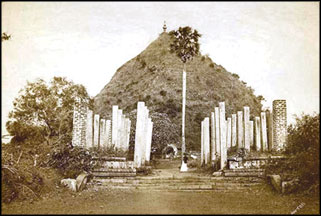How a great monument took shape
Known by many names such as Ruwanweliseya, Mahaseya, Swarnamali,
Ratna Mali, Hememali, Ruwanweli Dagaba or Maha Thupa, this majestic
piece of work is probably one of the most magnificent structures ever
built in the island. It is recognized as the central piece of the Maha
vihara (Great Monastery), was the most important monastery which guarded
Theravada Buddhism for years.
|

Ruwanweliseya during early times |
Another noteworthy aspect of the dagaba is the pains and the
dedication which the monarch had set into constructing each feature of
the fine white dagaba. Before King Dutugamunu's period the construction
of a temple on the site had been proposed by Arahath Mahinda and King
Tissa had even erected a tall stone pillar for this purpose. However it
was many years after their era that King Dutugamunu took to the task. He
had consulted several master builders and chosen the best one among the
500 who submitted tenders.
The building process began on a full moon Poya day in May 144 BC.
With foundation set in butter clay imported from India, bricks, iron,
rough cement and crystal, while god and silver added finishing touches
top the final composition.
It is believed that it cost King Dutugamunu 6.4 millions coins in
wages along with food, clothing and a few other facilities.
The stupa's name derives from the Sinhala terms gem and sand, some of
the resources which had initially been used to built the construction.
The architect had combined the construction with Buddhist philosophy so
that the monument symbolized a bubble of milk, representing life which
will burst in a matter of seconds, highlighting the uncertainty of life.
Its dorm depicts the vastness of the doctrine while the four facets of
the box signify the four noble truths. The concentric rings at the top
indicate the noble eightfold path that is man's guide to illumination.
Ancient scriptures relate that a bubble-shaped ruby as big as a man's
fist had been at the summit of the Maha Tupa but today a two feet high
rock crystal, donated by Burma, had replaced the original.
The surroundings of the stupa is dotted by rows of columns, often
about 500 cm high. They are the remains of many other building which had
not survived the years unlike the majestic monument which is considered
the most sacred of the dagabas by locals.
However the monument suffered from a number of South Indian invasions
and it is said that King Parakramabahu the Great carried out some
renovations to the stupa.
Similarly an inscription found near the Dolos Mahe Pahana (the lamp
that burns throughout the twelve months) by King Nissanka Malla records
the steps that were taken to repair the dagaba. Far from its original
height and form the Ruwanweliseya still remains intact, surrounded by
the wall of elephants, overlooking the ruins of the city and envelopes
and touches the devotees with a mind-soothing atmosphere. - Ruwini
|



